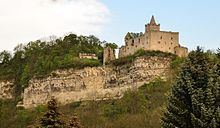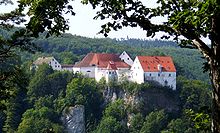Spurburg

A spur castle differs from other castles named after their different layouts, such as a summit castle , a hillside castle or a low castle, due to their special geographical location on a mountain spur , i.e. a terrain formation below the mountain top that slopes steeply on at least two sides.
A spur castle is therefore below the mountain peak, but steeply above the valley and is the most widespread type of hill castle in German-speaking countries.
Reasons for the plant
Regardless of the fact that the mountain spur has often offered itself as the topographically most favorable location for the construction of the castle, a spur castle has the advantage that the castle well - often the most money and time-consuming part of a castle - did not have to be dug as deep as in a summit castle and the entire system was closer to the road or ship connection to be protected. Often the water supply was ensured with the help of donkeys as pack animals via donkey paths specially created for this purpose .
Since the mountain spur drops steeply on at least two, sometimes three sides, it was necessary to protect a narrow side against attackers by a shield wall , a neck ditch or often a combination of these two defensive building elements.
Examples
Examples of spur castles in Germany are the ruins of Wachtenburg , the castle Balduinstein , the castle Eppstein , the castle Grimburg that Kriebstein Castle , the Castle Lahneck , the Liebenzell Castle and the Breidenstein Castle ; Probably the most northerly is the replicated ruin of Vlotho Castle in Vlotho . The defunct Helfenstein Castle (Koblenz) is now built over with the Helfenstein Fort . The Sparrenburg in Bielefeld is the northernmost preserved spur castle in Germany. One of the best-preserved spur castles in Germany is Wildenstein Castle (Leibertingen) .
An example of a spur castle in Scotland is Doune Castle .
literature
- Horst Wolfgang Böhme : Spornburg, location. In: Horst Wolfgang Böhme, Reinhard Friedrich, Barbara Schock-Werner (Hrsg.): Dictionary of castles, palaces and fortresses . Philipp Reclam, Stuttgart 2004, ISBN 3-15-010547-1 , pp. 232-233, doi: 10.11588 / arthistoricum.535 .
Individual evidence
- ↑ See Friedrich-Wilhelm Krahe: Castles of the German Middle Ages. Floor plan lexicon . Flechsig, Würzburg 2000, ISBN 3-88189-360-1 , p. 18 .
